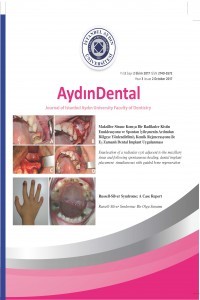Rubberdam Clamp Ingestion During Root Canal Treatment: A
rubber dam, yabancı cisim yutulması, vaka raporları
Rubberdam Clamp Ingestion During Root Canal Treatment: A
rubber dam, foreign body ingestion, case reports,
___
- [1] European Society of Endodontology. Consensus report of theEuropean Society of Endodontology on quality guidelines for endodontic treatment. Int Endod J 1994;27,115-24
- [2] Ahmad IA. Rubber dam usage for endodontic treatment: a review. Int Endod J 2009;42,963–72.
- [3] Susini G, Pommel L, Camps J. Accidental ingestion and aspiration of root canal instruments and other dental foreign bodies in a French population. Int Endod J. 2007;40,585–9.
- [4] Saha S, Bose A. Perils of Prolonged Impaction of Oesophageal Foreign Bodies. ISRN Surg 2011 ; ;2011:621682. doi: 10.5402/2011/621682
- [5] Tiwana KK, Morton T, Tiwana PS. Aspiration and ingestion in dental practice: a 10- year institutional review. J Am Dent Assoc 2004 ;135:1287-91.
- [6] Govila CP. Accidental swallowing of an endodontic instrument. A report of two cases. Oral Surg , Oral Med , Oral Pathol 1979;48, 269–71.
- [7] Sarah L.W. Sperry, BA,Seth D. Crockett, MD, MPH,C. Brock Miller, MD, Nicholas J. Shaheen, MD, MPH, Evan S. Dellon, MD, MPH Esophageal foreign-body impactions: epidemiology, time trends, and the impact of the increasing prevalence of eosinophilic esophagitis. Gastrointest Endosc 2011;74:985-91.
- ISSN: 2149-5572
- Yayın Aralığı: Yılda 3 Sayı
- Başlangıç: 2015
- Yayıncı: İstanbul Aydın Üniversitesi
Diş Beyazlatma Ürünlerinin Dentin Mikrosertliğine Etkileri
Buket AYNA, Emrah AYNA, Sema ÇELENK, Behiye BOLGÜL, Ersin UYSAL
Eroziv Lezyonlarin Direkt Kompozit Lamina Venerler ile Minimal İnvaziv Restorasyonu: Olgu
Rezin Nano Seramik Endokron: Post-Kor Destekli Kron Restorasyonlara Bir Alternatif
İşıl Kaya BÜYÜKBAYRAM, Gülce ALP
Endodontic Systems Working With Reciprocal Movements For Instrumentation of Root Canals
Lokalize Dişeti Çekilmesine Multidisipliner Yaklaşım: Bir Olgu Sunumu
Burcu KARADUMAN, Cenker KOYUNCUOĞLU, Sevda ATALAY, Ece ÇALIŞKAN, Nurcan TEZCİ, Sabri Hasan MERİÇ
Yumuşak Dokunun Estetik Tedavi Planındaki Yeri
Rubberdam Clamp Ingestion During Root Canal Treatment: A
Ece ÇALIŞKAN, Hafiz Hande GÜRBÜZ, Rüştü DAĞLAROĞLU, Raif ERİŞEN
